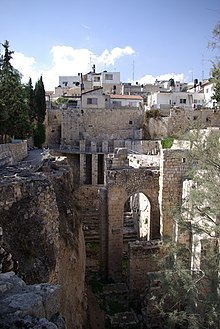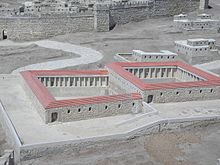User:Ret.Prof/sandbox1
POOL OF BETHESDA and JESUS
(Draft edits)

The Pool of Bethesda is an area of water in the Muslim Quarter of Jerusalem, on the path to the Beth Zeta Valley. The Gospel of John describes such a natatorium in Jerusalem, near the Sheep Gate, which was surrounded by five covered colonnades and was associated with healing. Up until the 19th century, there was no evidence outside of John’s Gospel for the existence of this pool. Scholars argued that this Gospel was written later, probably by someone without first-hand knowledge of the city of Jerusalem, and that the ‘pool’ had only a metaphorical meaning, rather than historical, significance.
Then in the 19th century, archaeologists discovered the remains of a pool exactly matching the description in John’s Gospel. Thus, archeology has confirmed the historical accuracy of John’s account. [1] [2] [3]
Name[edit]
There are varying forms of the "name" of this pool. Bethesda, Beth-zatha, Bethsaida, Bezatha, and Belzetha can be found in different ancient manuscripts. The Copper Scroll found in the Qumran Caves, indicates that "Bethesda" is most likely correct. Bethesda is said to be derived from the Aramaic language beth hesda (בית חסדא), meaning either house of mercy or house of grace. [4] [5] [6] [7]
Gospel of John[edit]
The Pool of Bethesda has been an area of controversy for Christian historians and archaeologists alike. According to the Gospel of John, Bethesda was a swimming bath (Greek: kolumbethra) with five porticos (translated as porches by older English bible translations).
The Gospel of John (5:1–15) describes one of Jesus' trips ( a Shabbat) to Judea where he heals a man who has been bedridden for many years, and could not make his own way into the pool. The Johannine narrative describes the porticos as being a place in which large numbers of infirm people were waiting for healing.[8] [9] [10]
Archaeology[edit]

Prior to archaeological digs, many scholars questioned the historicity of the Pool of Bethesda. However, in the 19th century, Herr K. Schick discovered a large tank situated about 100 feet north-west of St. Anne's Church, which he contended was the Pool of Bethesda.
Further archaeological investigation proved beyond a doubt that the description of this pool in the Gospel of John was not the creation of the Evangelist. This was an "astounding architectural achievement". Both the inscription and architectural style confirm that the Pool of Bethesda was one of the many "magnificent building projects of Herod the Great". The debris and ruins of many centuries were dumped into the pool, and later a Byzantine church constructed on top of it.
The Gospel of John reflects an accurate and detailed knowledge of the site. The Biblical account speaks of (a) the name of the pool as Bethesda; (b) its location near the Sheep Gate; (c) the fact that it has five porticos; with rushing water. All these details are corroborated by archaeological evidence affirming the historical accuracy of the Johannine account. [11] [12] [13] [14] [15] [16] [17]
References[edit]
- ^ Archaeological excavation confirmed the remains of the Byzantine and Crusader churches, Hadrian's Temple of Asclepius and Serapis, the small healing pools of the Asclepieion, the other of the two large pools, and the dam between them.
- ^ The Pool of Bethesda was identified with the modern so-called Fountain of the Virgin, in the Kidron Valley, not far from the Pool of Siloam, and alternately with the Birket Israel, a pool near the mouth of the valley which runs into the Kidron south of St. Stephen's Gate. Others identified it with the twin pools then called the Souterrains (French: Subterranean), under the Convent of the Sisters of Zion.
- ^ James H. Charlesworth, Jesus and archaeology, Wm. B. Eerdmans Publishing, 2006. pp 560-566
- ^ Walter A. Elwell, Philip Wesley Comfort, Tyndale Bible Dictionary, Tyndale House Publishers, Inc., 2001. p 164
- ^ Karen Armstrong, Jerusalem: One City, Three Faiths, Random House Publishing Group, 2011. p 109
- ^ D. A. Carson, The Gospel according to John (1991), page 241
- ^ Frederick Fyvie Bruce, The Gospel of John (1994), page 121-122
- ^ John 5:1–18
- ^ John McRay, Archaeology and the New Testament, Baker Academic, 2008. p 186
- ^ Some scholars have suggested that the narrative is actually part of a deliberate polemic against the Asclepius cult, an antagonism possibly partly brought on by the fact that Asclepius was worshipped as Saviour (Greek: Soter), in reference to his healing attributes. The narrative uses the Greek phrase hygies genesthai, which is not used anywhere in the Synoptic Gospels, but appears frequently in ancient testimonies to the healing powers of Asclepius.
- ^ James H. Charlesworth, Jesus and archaeology, Wm. B. Eerdmans Publishing, 2006. p 33 & 560-566
- ^ An archaeological diagram of the layout - the diagram displayed at the location itself - is visible at this link.
- ^ John McRay, Archaeology and the New Testament, Baker Academic, 2008. p 187
- ^ Walter A. Elwell, Philip Wesley Comfort, Tyndale Bible Dictionary, Tyndale House Publishers, Inc., 2001. p 164
- ^ Richard Swinburne, Revelation: From Metaphor to Analogy, Oxford University Press, 1992. p 105
- ^ D. Matthew Wilcox, The seven "Signs" through the eyes of John: A Deep Understanding of the Seven Miracles of Christ Presented in the Gospel of John, Mint Publishing Group, 2012.
- ^ Merrill C. Tenney, The Zondervan Encyclopedia of the Bible, Volume 5, Zondervan, 2010.
